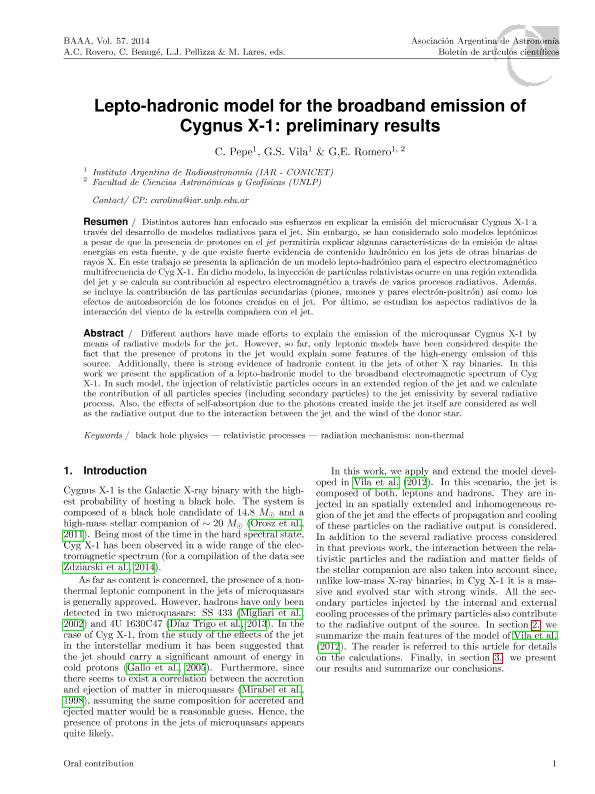Mostrar el registro sencillo del ítem
dc.contributor.author
Pepe, Carolina

dc.contributor.author
Vila, Gabriela Soledad

dc.contributor.author
Romero, Gustavo Esteban

dc.contributor.other
Carpintero, Daniel Diego

dc.contributor.other
Beauge, Cristian

dc.contributor.other
Pellizza González, Leonardo Javier

dc.contributor.other
Lares, Marcelo
dc.date.available
2021-08-31T01:59:03Z
dc.date.issued
2015
dc.identifier.citation
Lepto-hadronic model for the broadband emission of Cygnus X-1: preliminary results; Reunión Anual de la Asociación Argentina de Astronomía; Córdoba; Argentina; 2014; 228-230
dc.identifier.issn
0571-3285
dc.identifier.uri
http://hdl.handle.net/11336/139275
dc.description.abstract
Different authors have made efforts to explain the emission of the microquasar Cygnus X-1 by means of radiative models for the jet. However, so far, only leptonic models have been considered despite the fact that the presence of protons in the jet would explain some features of the high-energy emission of this source. Additionally, there is strong evidence of hadronic content in the jets of other X ray binaries. In this work we present the application of a lepto-hadronic model to the broadband electromagnetic spectrum of Cyg X-1. In such model, the injection of relativistic particles occurs in an extended region of the jet and we calculate the contribution of all particles species (including secondary particles) to the jet emissivity by several radiative process. Also, the effects of self-absortpion due to the photons created inside the jet itself are considered as well as the radiative output due to the interaction between the jet and the wind of the donor star.
dc.description.abstract
Distintos autores han enfocado sus esfuerzos en explicar la emisión del microcuásar Cygnus X-1 a través del desarrollo de modelos radiativos para el jet. Sin embargo, se han considerado solo modelos leptónicos a pesar de que la presencia de protones en el jet permitiría explicar algunas características de la emisión de altas energías en esta fuente, y de que existe fuerte evidencia de contenido hadrónico en los jets de otras binarias de rayos X. En este trabajo se presenta la aplicación de un modelo lepto-hadrónico para el espectro electromagnético multifrecuencia de Cyg X-1. En dicho modelo, la inyección de partículas relativistas ocurre en una región extendida del jet y se calcula su contribución al espectro electromagnético a través de varios procesos radiativos. Además, se incluye la contribución de las partículas secundarias (piones, muones y pares electrón-positrón) así como los efectos de autoabsorción de los fotones creados en el jet. Por último, se estudian los aspectos radiativos de la interacción del viento de la estrella compañera con el jet.
dc.format
application/pdf
dc.language.iso
eng
dc.publisher
Asociación Argentina de Astronomía
dc.rights
info:eu-repo/semantics/openAccess
dc.rights.uri
https://creativecommons.org/licenses/by-nc-sa/2.5/ar/
dc.subject
BLACK HOLE PHYSICS
dc.subject
RELATIVISTIC PROCESSES
dc.subject
RADIATION MECHANISMS: NON-THERMAL
dc.subject.classification
Astronomía

dc.subject.classification
Ciencias Físicas

dc.subject.classification
CIENCIAS NATURALES Y EXACTAS

dc.title
Lepto-hadronic model for the broadband emission of Cygnus X-1: preliminary results
dc.type
info:eu-repo/semantics/publishedVersion
dc.type
info:eu-repo/semantics/conferenceObject
dc.type
info:ar-repo/semantics/documento de conferencia
dc.date.updated
2021-08-25T17:41:33Z
dc.identifier.eissn
1669-9521
dc.journal.volume
57
dc.journal.pagination
228-230
dc.journal.pais
Argentina

dc.journal.ciudad
La Plata
dc.description.fil
Fil: Pepe, Carolina. Provincia de Buenos Aires. Gobernación. Comisión de Investigaciones Científicas. Instituto Argentino de Radioastronomía. Consejo Nacional de Investigaciones Científicas y Técnicas. Centro Científico Tecnológico Conicet - La Plata. Instituto Argentino de Radioastronomía; Argentina. Universidad Nacional de La Plata. Facultad de Ciencias Astronómicas y Geofísicas; Argentina
dc.description.fil
Fil: Vila, Gabriela Soledad. Provincia de Buenos Aires. Gobernación. Comisión de Investigaciones Científicas. Instituto Argentino de Radioastronomía. Consejo Nacional de Investigaciones Científicas y Técnicas. Centro Científico Tecnológico Conicet - La Plata. Instituto Argentino de Radioastronomía; Argentina. Universidad Nacional de La Plata. Facultad de Ciencias Astronómicas y Geofísicas; Argentina
dc.description.fil
Fil: Romero, Gustavo Esteban. Provincia de Buenos Aires. Gobernación. Comisión de Investigaciones Científicas. Instituto Argentino de Radioastronomía. Consejo Nacional de Investigaciones Científicas y Técnicas. Centro Científico Tecnológico Conicet - La Plata. Instituto Argentino de Radioastronomía; Argentina
dc.relation.alternativeid
info:eu-repo/semantics/altIdentifier/url/http://www.astronomiaargentina.org.ar/uploads/docs/baaa57.pdf
dc.relation.alternativeid
info:eu-repo/semantics/altIdentifier/url/http://www.astronomiaargentina.org.ar/articulo/2015/3/18/ediciones_anteriores_baaa
dc.conicet.rol
Autor

dc.conicet.rol
Autor

dc.conicet.rol
Autor

dc.coverage
Nacional
dc.type.subtype
Reunión
dc.description.nombreEvento
Reunión Anual de la Asociación Argentina de Astronomía
dc.date.evento
2014-09-15
dc.description.ciudadEvento
Córdoba
dc.description.paisEvento
Argentina

dc.type.publicacion
Journal
dc.description.institucionOrganizadora
Instituto de Astronomía Teórica y Experimental
dc.source.revista
Boletín de la Asociación Argentina de Astronomía
dc.date.eventoHasta
2014-09-19
dc.type
Reunión
Archivos asociados
